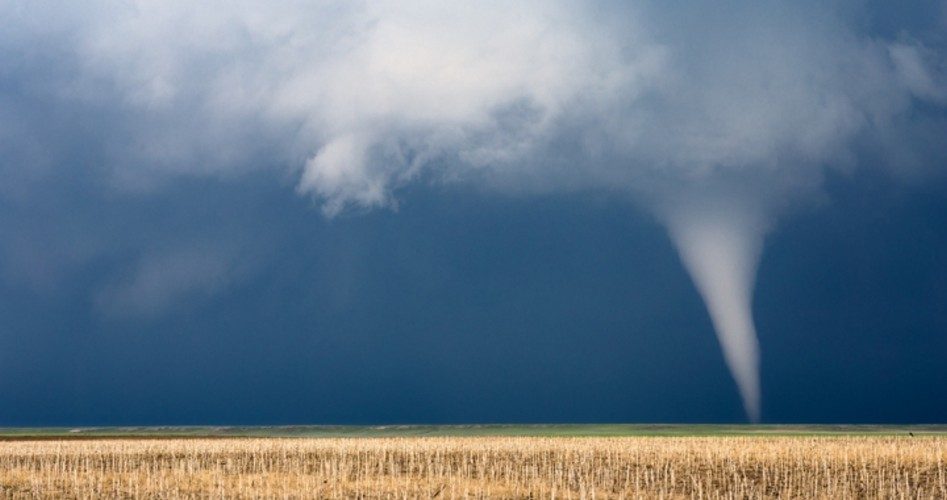
It’s been a rough year for tornado activity. Nearly 1,000 tornadoes have been reported so far this year, more than 200 twisters above the normal annual pace. In just the past 30 days, more than 500 tornadoes have been reported, a high number even for spring, which is considered tornado season in the United States. Over 300 twisters have been reported in just the past 11 days.
Climate hysterics have been quick to blame the 2019 tornado season on climate change.
After an early March tornado blasted Lee County in Alabama, presidential candidate Bernie Sanders (I-Vt.) posted on Facebook, “The science is clear, climate change is making extreme weather events, including tornadoes, worse. We must prepare for the impact of climate change that we know are [sic] coming.”
On May 23, Sanders’ ally and co-creator of the Green New Deal, Representative Alexandria Ocasio-Cortez (D -N.Y.), acted like the frightened little girl she probably is by posting a live reaction of a tornado watch in Washington, D.C., on Instagram. “Guys, they just issued a tornado watch in DC,” AOC says in a hushed tone. After showing a brief glimpse of a downpour outside, the neophyte congresswoman and climate hysteric laments, “There’s people stuck outside. We need to get them out. This is crazy.”
Not only does the congresswoman not know the difference between climate and weather, it seems the difference between a tornado watch and a tornado warning eludes her as well.
Later, AOC did what’s in her nature by attempting to link the unusual weather to her pet subject — climate change. “Tornadoes are challenging to link to climate change due to their nature,” she informed her Instagram followers. “But we DO know that tornadoes HAVE been changing. They are no longer being limited to the Great Plains and are shifting to other regions of the country.”
“The climate crisis is real, I’ll…guess we’re at casual tornadoes in growing regions of the country.”
{modulepos inner_text_ad}
Luckily, we have actual meteorologists to tell us what’s really going on.
Meteorologist Ryan Maue trolled AOC’s naiveté about tornadoes on Twitter. “The congresswoman @AOC does not know the difference between weather and climate. Let’s try an easy analogy: Weather is what outfit you wear heading out the door. Climate is your closet wardrobe.”
In a separate thread, Maue called the connection between increased tornadoes and climate change “tissue paper thin.”
Oddly, neither AOC nor Sanders had any comment on last year’s “drought” of tornadoes. Guess that didn’t fit the climate-change disaster narrative too well. According to Dr. Roy Spencer, the climate hysterics would have done better to blame last year’s dearth of the deadly twisters on global warming than this year’s surplus of the storms.
In an op-ed published by Fox News, Spencer explained: “With the devastating Dayton, Ohio tornadoes fresh on our minds, it is useful to examine exactly why (modest) global warming has produced fewer — not more — of such events.
“The simple answer is that tornado formation requires unusually cool air.”
Spencer explains that very few thunderstorms actually produce tornadoes. In the more hot and humid tropics, tornadoes are almost completely unheard of. Unlike their larger cousin hurricanes, tornadoes require strong wind shear — wind speed increasing with changing direction and height in the lower atmosphere.
“These conditions only exist when a cool air mass collides with a warm air mass,” explained Spencer. He added, “And the perfect conditions for this have existed this year as winter has refused to lose its grip on the western United States. So far for the month of May 2019, the average temperature across the U.S. is close to 2 degrees Fahrenheit below normal.”
But to climate hysterics, tornadoes are the same as hurricanes, which are the same as wildfires, which are the same as any other anomalous weather condition: They provide pictures of devastation that climate alarmists can point to in order to try to provoke a fear response among those who question the theory behind anthropogenic climate change. The facts of what is actually behind these weather events do not matter — only film of the unfortunate people sorting through debris in the aftermath of them does.
Image: mdesigner125 via iStock / Getty Images Plus




